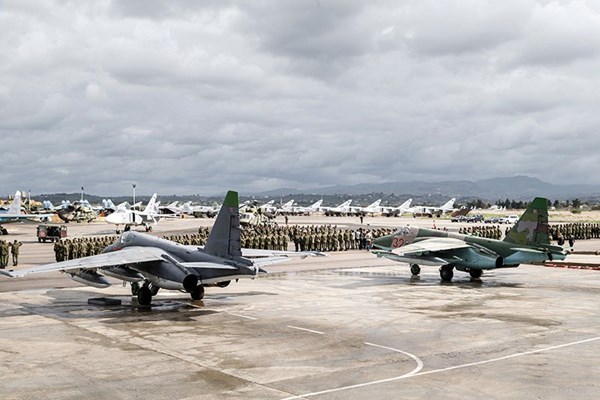Operation in Syria could cost Russia up to $535 million
According to the RBC media outlet, Russia could spend at least 38 billion rubles or up to $535 million on the military operation in Syria. Since the beginning of the campaign its costs could have grown by almost half.
Costs per day
During Russia's 167-day military campaign in Syria the daily cost of operations could have grown by almost 50%, RBC estimates, basing its calculation on the data that was revealed by the Defense Ministry and the experts' evaluations.
At the end of October 2015 the cost of one day of operations amounted to approximately 156,300 rubles (about 2.5 million dollars at the exchange rate at the time), RBC reported during the investigation named "How much Russia spends on the war in Syria." The calculations took into account spending on combat flights, salaries, the daily maintenance of the military and the delivery of goods, as well as transportation costs.
Since the beginning of the campaign the number of Russian aircraft has increased from 50 to 70. Hmeymim airfield deployed the latest Su-35 “Flanker” multi-role fighter jets and S-400 surface-to-air missile defense systems. All this could balloon the cost of daily operations to 230 million rubles (3.3 million dollars). Overall, the cost of operation in Syria could be estimated at 38.4 billion rubles or about 546 million dollars.
Bloomberg news agency reported in December 2015, citing a source in the government, that Moscow will spend at least 1.2 billion dollars on military operations in 2016 or 3.28 million dollars per day, which roughly corresponds to the RBC estimations.
"These are very approximate figures, but I would agree with this assessment," the director of the Center for Analysis of Strategies and Technologies, Ruslan Pukhov said commenting on the RBC calculations. In general, the cost of Russian military action proved to be very moderate, the expert said: "A series of military exercises during a year costs more."
The price of flight
The bulk of the military expenditures went to combat flights. During the entire operation, Russian planes, including the latest Su-35 multi-role fighters, Su-34, Su-24 and Su-25 jets carried out 8,659 sorties, according to the Ministry of Defense data on February 27th. RBC calculations indicate these expenses could amount to about 33.7 billion rubles.
In Syria, combat missions are divided into three categories according to the radius of the flight range from the airbase: close, middle and long-range. According to official reports, about 80% of flights were done within close range or less than 40 minutes. The remaining middle and long distance flights would last one to one and a half hours but accounted for no more than 20% of total flight time. Taking into account the ammunition reserves, sources and experts of RBC estimated the approximate cost of the combat mission for a close range flight to amount to 3.5 million rubles while a long range flight would cost 5.5 million rubles.
The launch of cruise missiles is a second costly item on the list of expenditures. In total, 48 Kalibr cruise missiles were launched in Syria. Compared to the launch of its U.S. counterpart, the Tomahawk missile, experts estimate that launching a Kalibr costs at least 750 thousand dollars. Thus, the demonstration of the latest missiles could cost the Ministry of Defense 36 million dollars, or 2.4 billion rubles.
Other expenses
During the campaign, the Russian military lost three soldiers: the pilot of the Su-24 that was downed by Turkey, the Marine who was part of the rescue operation and a military adviser who was killed by mortar fire. Payments to the relatives after the death of each soldier amounted to 3 million rubles. Some military equipment was also destroyed- a Su-24 bomber and a Mi-8 helicopter. According to Forbes, their value may amount to 390 million rubles and 1.1 billion rubles respectively.
The exact number of Russian soldiers stationed in Syria was not disclosed. As of the end of October, two sources of RBC in the Ministry of Defense reported that the number of Syrian troops is 1,600. In November, Reuters reported, citing its own sources, that the Russian contingent in Syria had been increased to four thousand soldiers. The only additional payments from the budget to Russian military involved in the Syrian operations go to an allowance for travel to the territory of a foreign state by a member of the Russian Presidential Human Rights Council, Sergey Krivenko, who works on protection of the rights of military personnel. According to calculations made on the basis of the Ministry of Defense data on payments per person, the amount of additional allowance for each member of the Russian military for participating in the Syrian operations is 18 dollars and 6 cents per day. Taking into account the number of military personnel, spending could reach about 800 million rubles.
About 1 billion rubles could take up transport expenditures. It includes the daily flights of IL-76 and AN-124 aircraft from Mozdok to Latakia, as well as the use of cargo ships to deliver goods by sea.
The cost of the withdrawal of troops from the Hmeymim airbase is difficult to estimate, since it's still unclear which forces will remain at the airbase in Latakia and which will return to the places of their permanent duty. The fate of the deployed air defense systems is also unclear.
Officially, spending on the Syrian campaign wasn't made public. Prime Minister Dmitry Medvedev, responding to a question on the cost of the operation, said in December "It's a secret." He only said that "spending of the Russian Armed Forces fits perfectly within the parameters of the budget of the Ministry of Defense." The Prime Minister also added "They didn't ask for an increase in defense spending."
The Defense Ministry does not advertise information about the cost of operations in Syria.
